Maximizing Value with an Integrated Methodology
Executive Summary
Inbound Marketing takes the old business maxim of the customer-centered business and operationalizes the concept across all aspects of the customer journey, from above the funnel to far beyond it. Using multi-disciplinary tools and expertise, brands today can optimize the customer and marketing flows so that both brand and customer maximize their benefits throughout the relationship.
- Why Should Brands Adopt Inbound Marketing?
- How Does It Work: The Philosophy and Value System
- How Does it Work: Turning Philosophy into Operations
- How is Value Delivered?
- Accelerating the Process
- Measuring Success
What is Inbound Marketing?
Inbound marketing is invariably defined in one of two ways: a simple memorable phrase describing the overall essence or philosophy, or a complex set of customer journey steps, with critical actions and reactions described or implied at each step.
Inbound marketing is both: a simple customer-centric philosophy or ethos and a complex series of interrelated and cyclical actions across the customer journey that reflects the philosophy.
The philosophy that animates inbound marketing is simple:
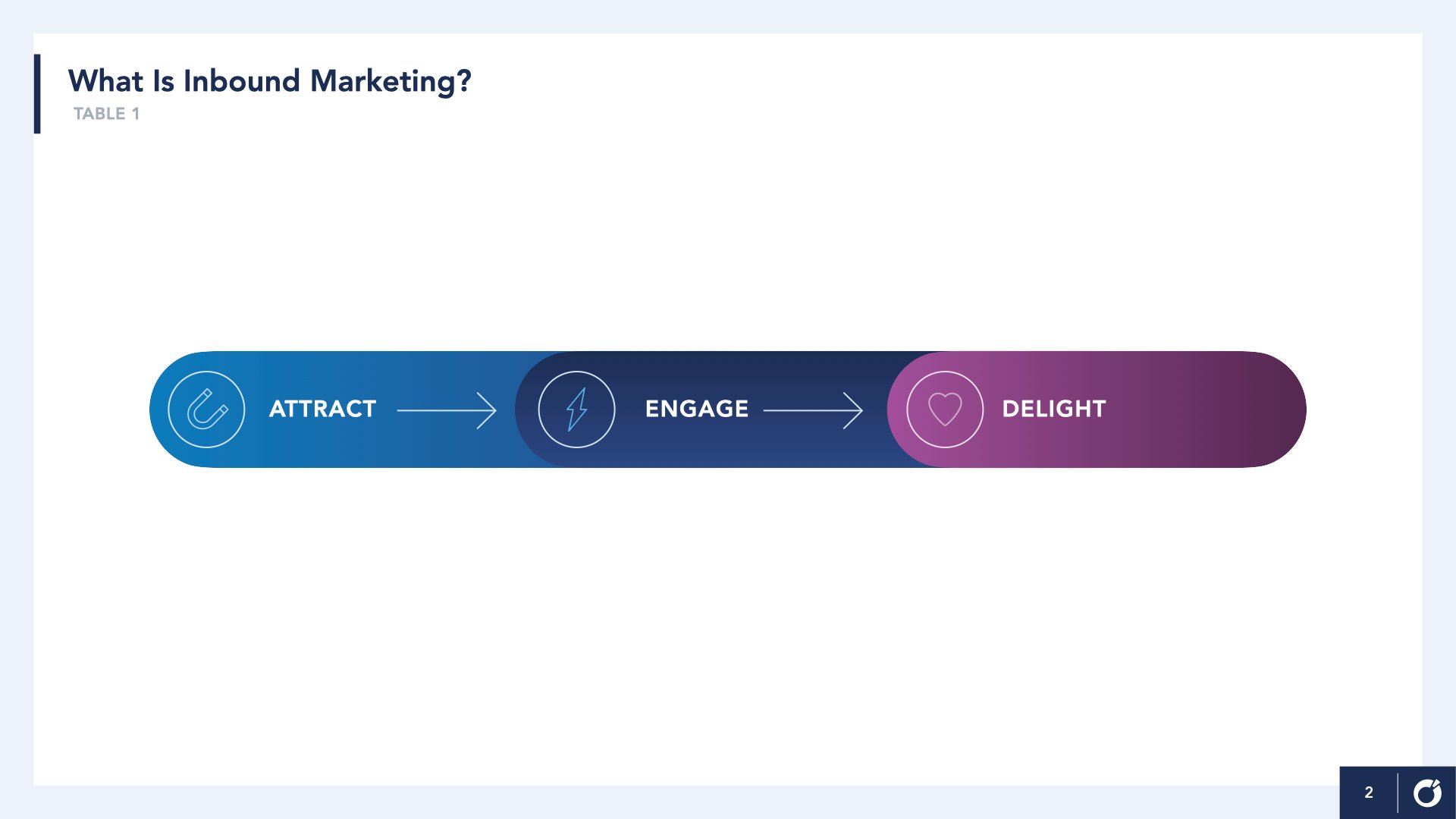
Each word of the philosophy captures the core action and is a signal for the full meaning of the inbound marketing phase represented, but only experienced practitioners understand all the implications.
Effective inbound marketing attracts and engages prospects by providing value aligned with their needs, in a non-disruptive and customer-centric experience that allows buyers to control their journey. As prospects select content and brand interactions that speak to their needs, the brand can demonstrate expertise and build trust, establishing itself as a valuable partner in the buyer’s fulfillment chain. The brand engages customers far above the sales funnel, and continues to delight them after purchases by providing guidance and support to ensure customers experience success with their purchases.
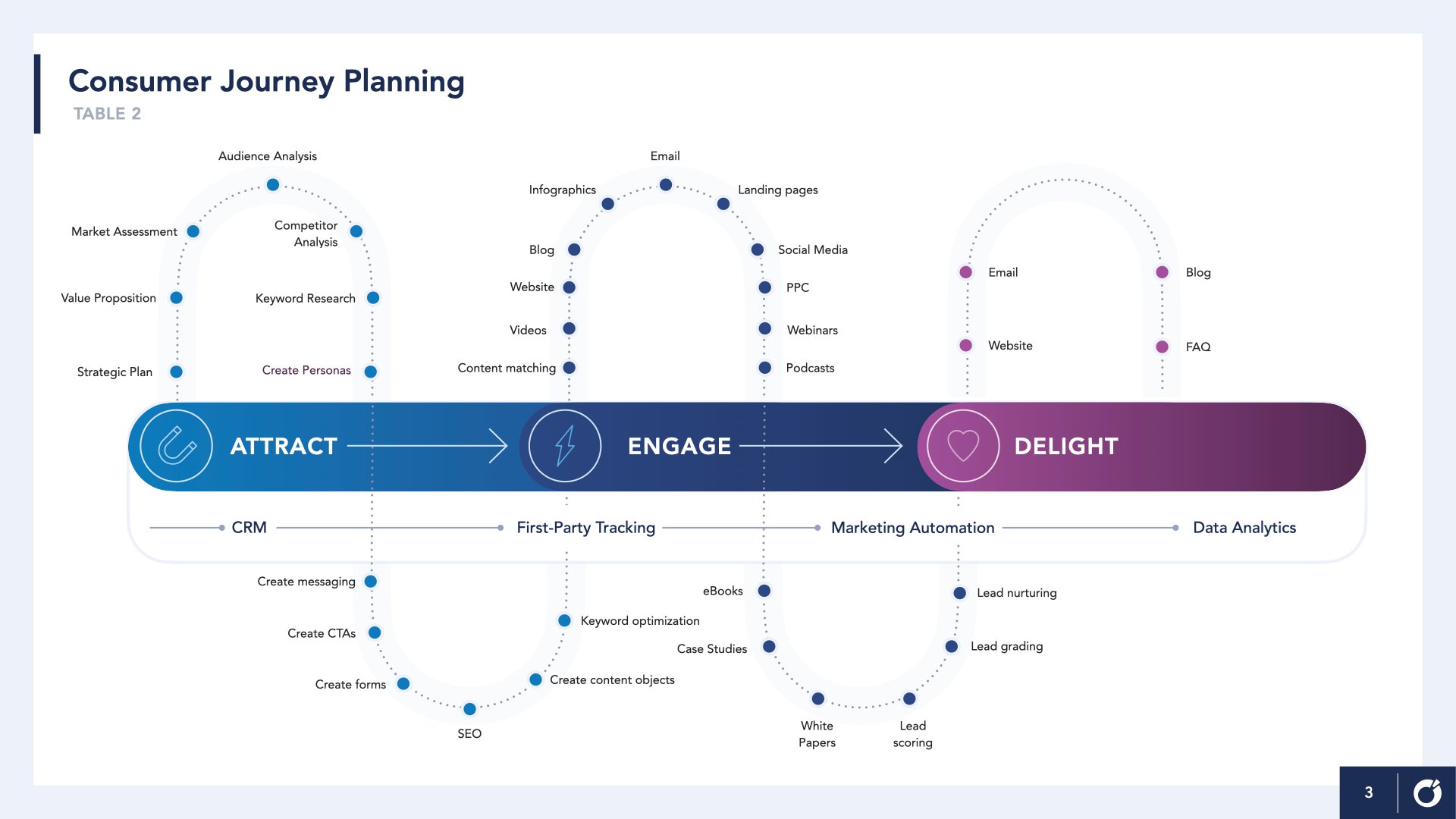
Today’s customer journeys are increasingly complex, requiring brands to employ sophisticated multi-disciplinary marketing strategies and tactics to facilitate. Intense competition and a maze of channels and content create opportunities for seemingly unpredictable buyer journeys. Brands armed with strategic planning, competitive market analysis, data science maturity, and omnichannel expertise can operationalize the inbound philosophy.
Why Inbound Marketing?
Inbound marketing methodologies are used worldwide, applied across almost any product or service category, and provide returns to consumers and businesses that have only increased in popularity since the term was coined 15 years ago.
Consumer Demand
Inbound marketing responds directly to consumer behavior and preferences. Consumers use the internet to research purchase options, searching for specific answers and information using search engines, social media, and brand sites. For those making larger purchases with long sales cycles, the transactions are not impulse purchases, but investments. As a result, they will generally research and compare with competitors to ensure that the selected brand demonstrates value in all customer-facing content and brand interactions. Contemporary customers expect (and find) all the data needed to make a decision. If a brand doesn’t contribute to this data pool, they will not compete with those who do.
After years of increasingly intrusive and annoying online ads targeting internet users, many prefer a less disruptive experience in which they choose where and how to engage brands. Inbound marketing provides consumers with more control over their journey, the brand interaction, the pace of the customer journey, and content that meets their specific needs.
Broad Domains of Application
Inbound practices and strategies encompass a wide variety of channels, domains, tactics, and content. Consequently, any brand can identify multiple approaches that align well with a unique value proposition, set of digital assets, product or service offering, and discrete buyer personas.
All the targeting power of various domains allows inbound marketing to reach any prospect, with brands able to plan content funnels addressing prospects across every customer journey.
Because inbound marketing uses varied marketing tactics simultaneously, the synergies can improve performance across channels and domains: improve site visibility and keyword ranking, social media shares and sentiment, brand awareness, share of voice (SOV), content quality, paid advertising cost and reach, user experience, and individual’s customer journeys. Moreover, combining all of the elements and strategies of inbound marketing can elevate the brand’s digital assets from their individual utilitarian functions to an efficient and effective lead generator, nurturer, and conversion tool.
Share of Voice as a Strategic Accelerator
Before the digital revolution, Share of Voice (SOV) was a standard metric to determine a brand’s share of ...
Sales Process Synergies
Inbound methodology creates a self-selection process for customers: when marketing components are aligned (keywords, messaging, value proposition), customers will visit if their needs correspond with the brand offering. As visitors select specific content and interactions, they further segment into specific needs, first-party tracking creates data profiles that feed lead grading and scoring models. This effective auto-segmenting provides sales with detailed customer information and pre-qualified leads before they engage buyers.
After enough visitor and customer data is captured, marketers can build an increasingly accurate scoring and lifetime value (LTV) model tied to different profile characteristics, allowing sales to focus on higher-value prospects. Finally, because inbound marketing is designed to reach prospects at all points in their individual customer journeys, the detailed data and scoring model informs content matching to provide the right information to all visitors regardless of buyer readiness.
Overcome Data Tracking Challenges
While inbound marketing is growing for several reasons, the increasing challenge around tracking helps drive an opt-in for value exchange model. Rather than depend on third-party cookies for behavioral targeting across different websites, inbound marketing attracts customers based on their need and willingness to opt-in to first-party marketing in exchange for relevant value. Data capture from contact forms as well as from brand interaction tracking can be aggregated into customer data and analytics platforms. Brands can apply audience insights and enhance their inbound strategies to better connect with prospects and more quickly convert them to leads and customers--all without reliance on third-party cookies.
Organic Benefits
The majority of inbound marketing is organic; that is, inbound does not depend on purchased traffic or leads. In fact, many inbound strategies and tactics are aimed at ensuring prospects can easily find relevant content without paid advertising campaigns. Both on-page and off-page search engine optimization (SEO) practices can raise a brand’s visibility and increase the opportunity that visitors can find brand assets organically. While some brands depend solely on organic traffic, others may choose to use limited advertising in search engines or social media to attract visitors to brand websites, often to kick-start an inbound strategy. For example, brands might promote posts on Facebook, or target precise keyword combinations in search advertising. Brands running both inbound and paid ad campaigns will gain from the reinforcement provided by each.
Automation Opportunities
Once a comprehensive set of digital assets are created and deployed, the Attract phase of inbound marketing can perform for the brand 24/7. When integrated with a well-configured marketing automation platform, the brand can interact with prospects non-stop as well, and doesn’t stop when a budget is expended within an ad platform. With the addition of customer data platforms (CRM, CDP) and automation tools, inbound marketing can be run with lean resources. With data-driven automation, inbound campaigns can be measured and optimized using real-time and aggregate data, continuously revised to match changing environments, new customer insights and targets, and new brand strategies and campaigns.
Long Cycle Advantage
Businesses searching for B2B products and services are often seeking long-term suppliers or significant purchases that create a long sales cycle. The extended customer journey length provides an opportunity for brands to educate and build trust by providing targeted relevant content in the variety of formats and channels that resonate most with target audiences.
Authenticity and Credibility
In an age of ubiquitous advertising, consumers may find little to differentiate brands through online ads purporting to be the lowest cost, highest performing, most amenities, etc. Consumers planning a purchase, from small electronics to larger B2B purchases, want to invest in products and services with brands they can trust. Inbound marketing allows brands to demonstrate value through consistently providing helpful, relevant answers based on expertise. Throughout the sales cycle, brands that demonstrate communication, transparency, and knowledge sharing build an authentic voice and trust. Brands that focus on the customer’s needs from above the funnel to post-purchase create brand value. When that value is reinforced across the lifecycle through action, messaging, and delivery, brand value is disseminated by advocates.
Results
Inbound marketing is widely used as a primary strategy, costs less per lead than outbound, and has ten times the conversion rate. Nurturing the leads drives 50 percent more sales and is cheaper than non-nurtured leads. Companies that automate lead management see a 10 percent or greater increase in revenue in 6-9 months. The opportunity exists because most consumers would rather learn about a company through finding content rather than receive advertising.
How does Inbound Marketing Work?
The Customer-Centered Philosophy
The driving philosophy of inbound marketing is captured in the 3-step model popularized by HubSpot:
- Attract visitors (rather than send unsolicited messaging and content to them)
- Engage prospects and leads (allowing the consumer to choose content, interaction, and pace)
- Delight them (by supporting customers after purchase)
Other popular models follow a similar path, attracting targeted visitors with quality content, engaging and nurturing them through the customer journey to become a satisfied and delighted advocate.
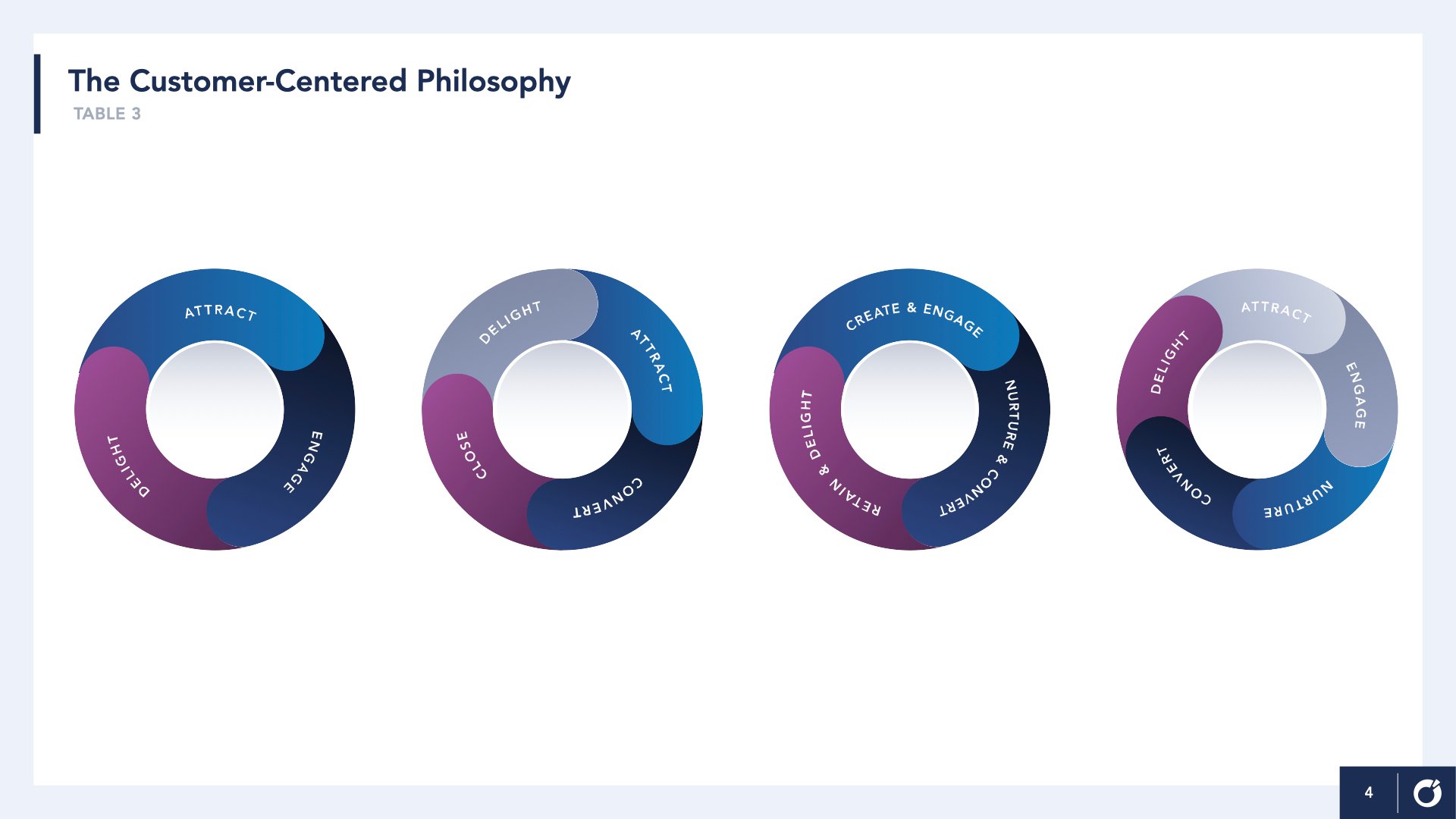
Brands operationalize the inbound philosophy by creating the objects, interactions, and paths that function to attract, engage, and delight customers. Using technical and creative tools and talents, marketing teams build the inbound funnels that fulfill the values of the inbound philosophy. When operationalized well, the inbound philosophy creates an optimum experience for prospects and customers. Those experiences, in turn, drive unique benefits for the brand far beyond its conversion goals.
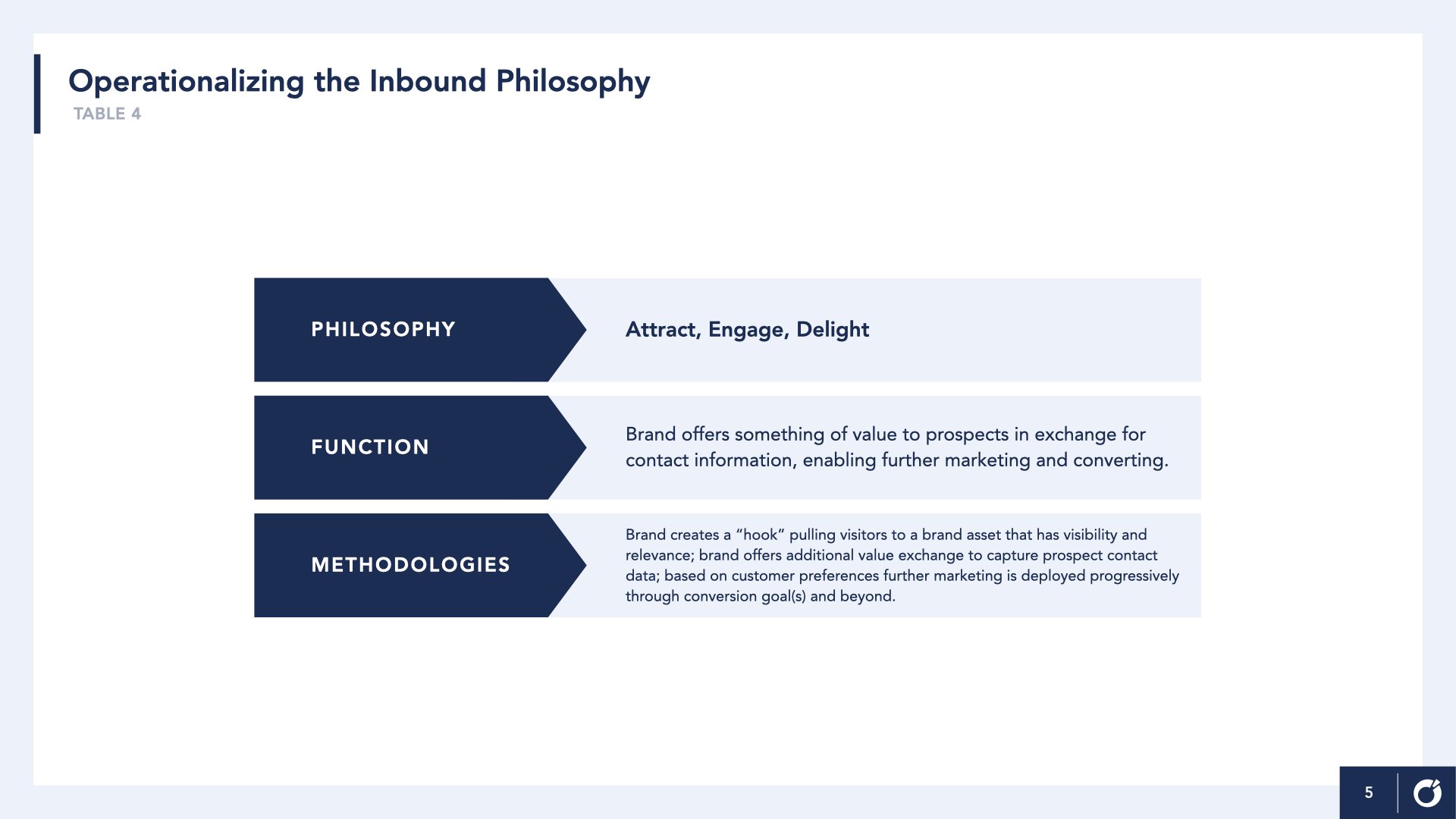
The Unique Value Proposition of Inbound Methodology
For over a decade, inbound marketing has proven to generate leads, revenue, and ROI as well. However, it is the soft non-financial metrics tied to the inbound ethos that helps drive that revenue success.
The User Experience
Inbound marketing generates qualified leads with strategies that complement each other, with all tactics reinforcing a customer-focused value that conveys credibility and builds trust. The user experience is central to delivering that value. In a 2020 study, the customer experience was the number one key brand differentiator for B2B purchasers, beating out both product and price. B2B buyers want products and services that are easy to understand, buy, and use.
Content is developed for each targeted persona, at every location in the sales funnel, not merely because it drives the customer journey toward conversion, but because customers’ needs differ based on their journey location: relevant content and question answers are required whether they are browsing a potential interest area, learning how a domain functions, or weighing product pros and cons. Content is based on customer needs, not just product alignment.
The brand’s content must be accessible, simple to locate, and easy to process. Inbound marketing is where the customer is. For every targeted persona, optimum channels and tactics exist to ensure prospects easily find what they need when they need it: social media (Facebook or Twitter feeds, LinkedIn posts), search engines (organic rankings, knowledge panels), industry journals or blogs (e.g., guest posts and articles), even in email. By matching keywords and messaging across touchpoints for different customer journey points, brands ensure that visitors reach answers that are cogently accessible for their context. Above-funnel visitors will follow keyword hooks to a matching content level, e.g., “top reasons why [product category or type] are successful.” Buyers near the funnel bottom are attracted by different keywords and hooks leading to more precise information, e.g., white papers, specific live webinars, demo requests.
Finally, inbound is user-directed, choosing content and brand interactions based on the need now, and at the customer’s desired pace. Visitors find what they need, when they need it, and engage in the manner they choose.
When customers solve their problems with a superior brand offering, and experience a customer-centered brand, one that demonstrates expertise, credibility, and trust, they are more likely to share the experience with others, and drive prospects to the brand. This is what HubSpot calls “the flywheel” business model: the way inbound marketing, through satisfied customer advocates, creates “a self-sustaining loop.”
The Brand Experience
While the overall financial goal of inbound marketing may be summed up as the generation of qualified leads and the sales and revenue that follow, the corresponding benefits generated by inbound lead generation methods are goals in their own right.
The customer-centered tactics and motifs throughout inbound create an environment in which the customers are valued beyond a quick conversion. The intention to solve customer challenges dominates brand interactions.
The level of industry or domain knowledge required for the brand to function in the role establishes a level of expertise. In order to reach consumers at all levels of the buyer journey, the brand must effectively demonstrate a broad and specific knowledge and experience, lucidly describing a domain landscape or clarifying specific attributes.
The absence of hard-selling contributes to integrity and trust. The omnichannel and broad tactics used keep brands from appearing to be an invariant, one-dimensional brand. The overwhelming messaging opportunity does permit, however, a brand to define itself: who they are, what they do, how they do it, and the values and principles that guide them.
However, the multi-disciplinary expertise demanded by a fully integrated inbound methodology differs profoundly from that required, for example, simply to manage a blog for generating leads. Indeed, the breadth and depth of the methodology across all brand properties, interactions, and messaging are what powers the non-financial benefits to the brand.
Remember, the goal is conversion to a paying customer. The partnership model, the trust, the advisory role—can be an ethos informing the entire brand, but without the sale, the brand does not exist.
Operationalizing the Buyer Journey
Methodologies for inbound marketing must attract traffic aligned with the brand’s value proposition, convert visitors to leads, progressively facilitate conversion using customers’ preferences, and continue to support their success post-purchase. In order to operationalize an Attract-Engage-Delight philosophy, brands must design and develop the content objects, the targeting hooks, and mechanisms, the messaging, the lead management techniques and tools, and the data capture processes that power it all.
Targeting
Because 90 percent of B2B customers and over 80 percent of retail shoppers begin their purchase journey with an online search, brands need to maintain a current Search Engine Optimization (SEO) strategy. Attracting consumers that match the personas tied to the value proposition allows the brand to engage with target segments as soon as they land on brand property.
Search Engine Optimization (SEO)
The quality and relevance of brand content are irrelevant if prospects cannot easily find it. Inbound marketing depends on creating the right content and ensuring prospects can find it at the moment they need it. Search Engine Optimization (SEO) is the broad set of practices that increase a company’s visibility in organic search results. SEO impacts how easily a visitor can find a brand’s content, and impacts the user experience off-page and on-page. While all brands competing online must maintain their digital profile, those dependent on inbound marketing are bound by it. To ensure their digital content is organically accessible when prospects need it, companies pair content strategies with SEO strategies that help bring the user to the brand. Moreover, leads initiated by prospects are often stronger, with SEO-generated inbound leads averaging over 14 percent close rate--eight times the average outbound sales conversion rate.
SEO practices fall into three general categories: technical SEO, on-page SEO, and off-page SEO.
Technical SEO helps customers find brand content, and improves their experience with the brand’s site.
- Creates structural elements of a brand’s site that helps search engines find and understand site content, thereby making it available to prospects seeking relevant content on a search engine: structured data with semantic flags, clear URL keyword structures that increase clarity, audits that eliminate errors.
- Ensures optimum user experiences: page-load optimization increases site speed, mobile optimization aligns content with device, and voice search optimization ensures the site is easily accessible by typical voice-driven queries.
On-page SEO helps customers find specific brand pages that match the intent of their search queries.
- Uses keyword research and analysis, to identify topic words and phrases that best align customer intent to company offering.
- Creates titles, headers, meta-tags, and content optimized with the highest-performing relevant keywords for each page.
Off-page SEO helps customers find a brand site by raising the general visibility level of a brand’s domain.
- Recognizes relevant brand content will not be displayed in a high-ranking Search Engine Result Page (SERP) position if the domain has poor authority and little demonstrated recognition.
- Builds links from authoritative sites that signal the trustworthiness and authority of the brand domain and page.
- Employs known authority signals that search engines use to determine ranking and visibility on SERPs.
Messaging And Data Capture
Once prospects find brand websites, effectively aligned messaging engages, creates compelling exchange value opportunities, seamlessly captures contact data, and nurtures visitors through their different customer journeys.
Effective Content Attributes
Any content, regardless of content type, must be accessible and engaging to the audience at their level of knowledge and expectations. Overly complex or inside jargon will turn away prospects new to an industry or offering category, just as overly simplified content will not engage visitors searching for new insights into a subject.
Content format should be designed for readability, using all textual and visual signs available to the content object type, such as titles and headers, use of available space, and icons. Different techniques and expectations exist for each content object type in a marketing mix: blog posts, white papers, eBooks, and podcasts each employ different tactics for the effective presentation of ideas. Any content that is shareable, should be made easily shareable.
Most importantly, content should be memorable, with eloquence matching audience level, and insights not found on many competitor brand sites. Encouraging visitors to submit personal information requires a value exchange that is worthwhile. Brands must provide relevant informative content, but even more compelling is the value of unique targeted content that is not available in multiple easily accessible locations across the internet.
CTAs and Messaging
The call-to-action (CTA) drives visitors to take another step in the customer journey, from the initial visit, to an exchange of personal information for specific content, to continued actions to further explore the brand offering.
Consistency and Alignment
All messaging should be consistent across landing pages, blog, product pages, and downloads, relating to and reinforcing the value proposition. However, variations in the message for different personas or locations in the buyer journey should tie the value proposition to the need of the personas and the aligned context.
With a strategically designed marketing mix, each component reinforces the value proposition and the key messages connected to it. When addressing prospects at different points of the customer journey, messaging can match each location in the funnel. For example:
- Prospects above the top of the funnel are mildly or tangentially interested, and may be interested in a definition or quick question. A publicly indexed knowledge base written for expected audiences can be responsive and memorable. Prospects who anticipate further questions might bookmark such a content repository for later access. Internal linking within the site ensures a later visit could be extended as a prospect’s interest deepens.
- Prospects with increased intent and in the consideration phase will benefit from a feature comparison or white paper addressing product application. Messaging at this stage includes brand-specific WIIFM, backed by statistics, case studies, and other compelling evidence that the brand offering provides the best fit for the prospect’s needs.
CTAs are used in any medium or channel, with each providing unique features to drive prospect action. Explainer or instructional videos can use CTAs for downloading a trial version of the software. Social media CTAs can drive visitors to specific dedicated landing pages on a brand product site or specific blog post. CTAs embedded further along the customer journey can reinforce the value and relevance of the next information available for specific consumer profiles. Most content objects can be freely available to prove value and entice visitors to exchange contact information, and any content can be pushed behind an “exchange transaction” whether it’s simple process checklists or in-depth white papers. In all cases, a visitor must perceive a likely value worth submitting personal information.
Dedicated Landing Pages
Ideally, each CTA should always send visitors to a dedicated landing page that aligns with the specific CTA focus, prospect interest, and phase of the buyer journey. Separating landing pages by persona or buying phase segments allows CTAs to point to messaging aligned with the prospect’s attributes and current expectations and needs. Sending a visitor with specific interests to a single main homepage places the burden on the visitor--instead of on the brand where it belongs. Effective CTAs deliver directly on the promise of the action.
Personalized and Smart CTAs
Personalized and smart CTAs allow even closer matching between prospect and messaging. By pulling data from a customer data platform (CDP, CRM, Marketing Automation), a CTA can populate with personalized data, from simply addressing a customer by name, to modifying an entire CTA by options driven by industry, and specific segments based on lead scoring and grading, purchase readiness, or other key attributes pertinent to a brand’s area of practice.
Effective Contact Data Capture
The customer engagement and nurturing that occurs during the buyer journey requires data to work, and capturing contact information provides an identifier key to which all first-party data and the larger profile connects.
What to Capture
Brands should limit the personal information request form to the basics, as each piece of personal information weighs against the prospect’s perception of the exchange value.
- Name: core information allowing personalized communication and an identifier that can be used for personalization and additional data gathering.
- Email: considered the standard non-scrubbed identifier key with which all other profiling connects, as well as a key marketing channel.
- Company: signals both the industry and the brand that feeds into lead grading.
- Location: identifies time zone for personalized communication and segmentation, additional profiling data (e.g., geographically decentralized companies), and any offering considerations driven by regional differences.
Progressive Profiling
Progressive profiling allows visitors to input smaller amounts of information across multiple visits, and can pre-populate some information if the form is connected with the brand’s CRM/CDP. When using progressive profiling, brands may choose to limit initial data capture, adding to the data as the prospect becomes more engaged. Some additional data points can be retrieved from quick company research, while later interactions must capture other key information, e.g., role at the company, and expected purchase timeline.
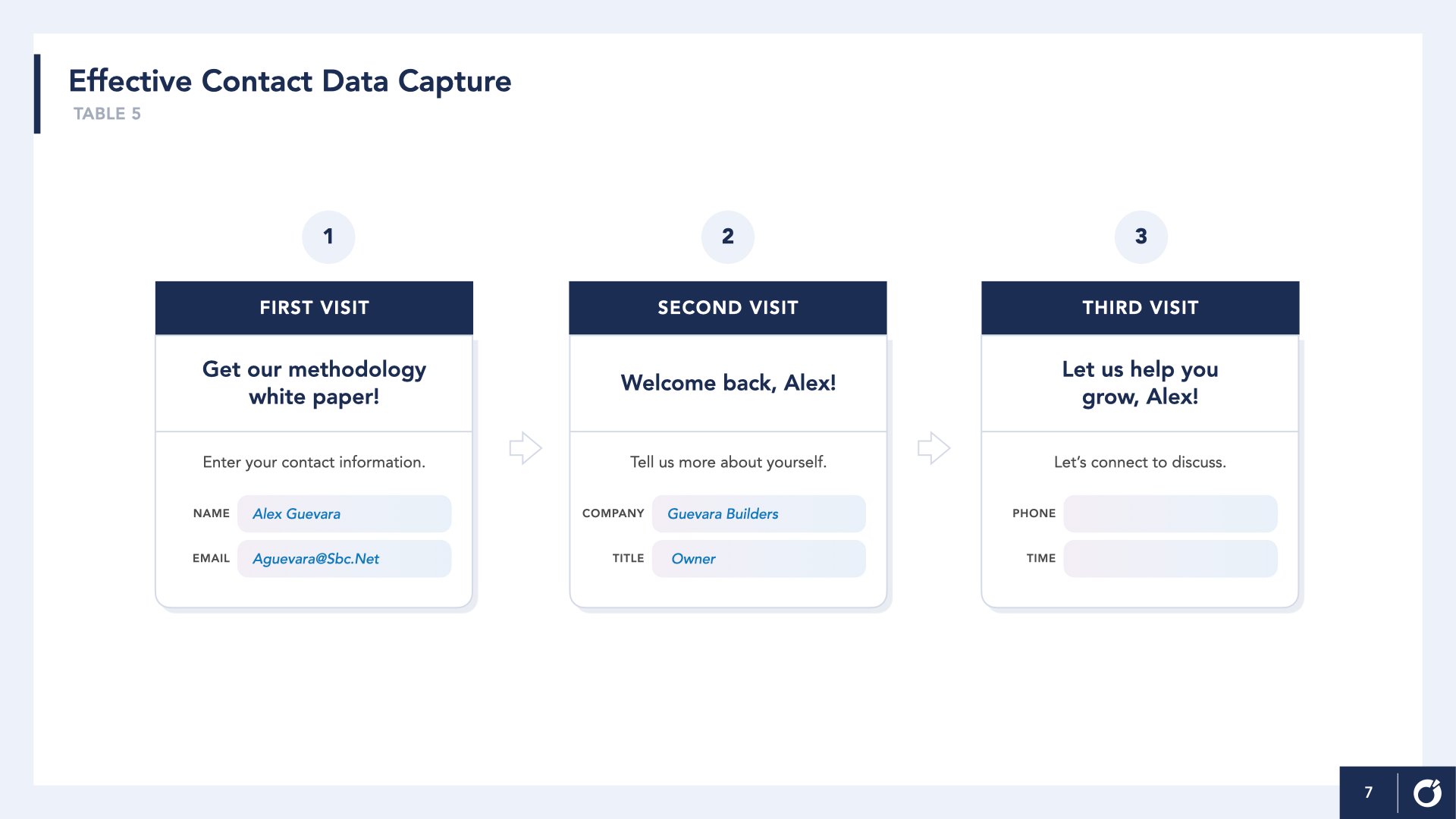
Placement
A traditional best practice is to include the data capture (and CTA) on a high-volume page; however, CTAs and profiling forms can be placed in numerous pages and objects as long as they are in the path of the targeted audience. Because inbound methodology guides prospects through their preferred customer journeys, multiple CTAs may be used at different junctions and decision points, driving users to the next targeted interaction as they move to conversion and beyond.
Lead Management
When unsolicited visitors arrive, they are already showing an organic interest in the brand offering. Lead generation begins with this interest in an offering, and is then strengthened or lessened by the content surrounding the offer. A visitor becomes a lead once a contact form has been completed and an offer is accessed.
Lead management tracks prospects from the initial contact data entry, through the buyer journey nurturing toward each educational and interest increase, to conversion and post-purchase support.
Both web analytics and contact form data build the user profiles, while the first piece of scoring data is the type of offer for which a prospect has expressed interest. Downloading a coupon, a general ebook, or product-specific white paper all connote different levels and types of interest.
Scoring and Grading
As both a targeted methodology and one based on self-selection, inbound marketing can limit the range of audiences attracted. Many visitors may express interest, but are above the top of the funnel, far from intent to purchase. The act of completing a contact for content access further segments visitors' interest levels. However, a well-planned inbound strategy uses a scoring and grading system based on historical data that accurately gauges prospects’ alignment with offering and intent to buy. Lead scoring assigns a numerical value based on a prospect's intent to purchase, while lead grading measures how well a prospect matches the ideal customer for the brand offering. Using historical data and insights from marketing and sales teams, standardized scoring and grading values are applied to behaviors and prospect attributes. In this way, a consistent measurement system can be accurately applied across the company or division, and the relative value can be calculated for each lead. As a result, sales can allocate resources to highest value prospects and content can be matched with each prospect’s current need across the funnel.
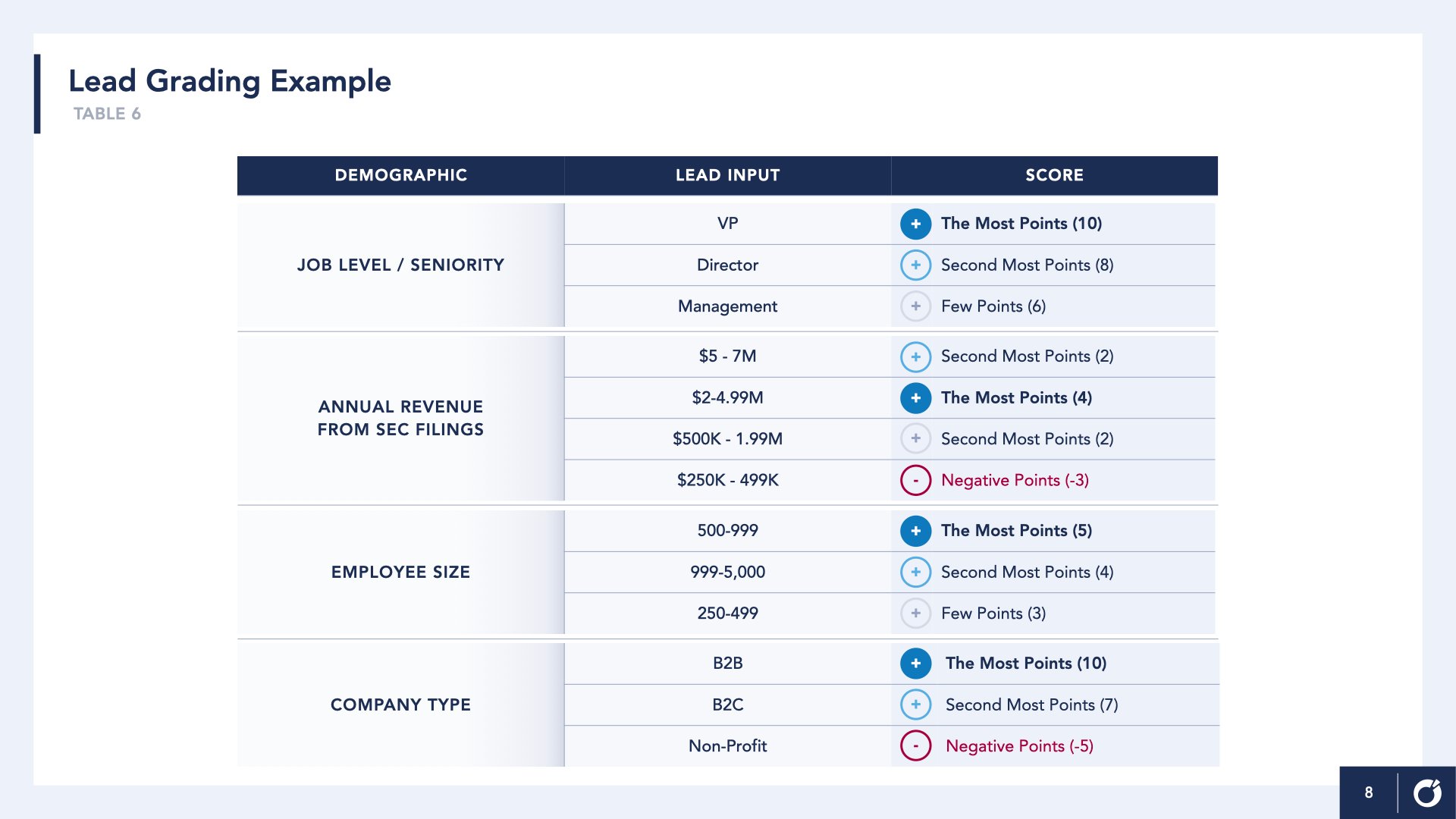
Nurturing
If the brand supplies prospects with something they need--something informative, relevant, or signals trust--then they are a lead and beginning a relationship. Brands nurture leads by developing relationships across the funnel, providing each buyer what he or she needs through continuous content and experience matching.
Designing inbound content and messaging for all targeted personas and visitors’ different readiness levels requires matching. Just as all brands must map out the customer journey through the sales funnel, an effective inbound strategy should have a content funnel to match. By providing tactics for multiple levels, customers will continue to visit and access additional content that guides them through the purchase.
Many of the tactics of traditional intrusive marketing still work inbound. While the customer must come to the brand, once they come, many prior techniques are applicable and effective.
One of the advantages of inbound is that marketers are effectively inviting only visitors who are most likely a potential customer, so fewer resources are expended for nurturing low-interest prospects. The brand is in effect, inviting the personas.
Delighting
In traditional marketing, the “Delight” phase is often left to the customer service team. However, to drive “the flywheel” or customer advocacy model, supporting customers post-purchase is integral to continuing the cycle of inbound marketing.
This cumulative customer experience builds trust, demonstrates expertise, and establishes credibility as a key resource for customers in their respective fields. Focusing on the customer’s needs, not the business’s desire to sell, creates a customer-centered experience in which the customer drives the journey within a hyper-responsive framework. The customer makes decisions throughout the research, comparison, and decisioning, while supported each step of the way by the brand. Content is client-centered, web design is client-centered, and interactions are client-centered.
Post-sale delighting of customers maintains the trust and credibility that drove the relationship originally. By acting as advisors to customers, a brand’s team can effectively continue the customer cycle, creating satisfied and engaged advocates who help drive new leads.
Content Delivery Strategies
Each element of the inbound methodology of the buyer journey expands or maintains reach, by attracting aligned prospects from across all elements on the search engine results page (SERP) to the diverse domain properties on which the brand is present. As the brand creates messaging strategies to reach targeted personas at all points in the customer journey, the selection of content delivery vehicles enhances the messaging through the unique attributes each content object or channel provides.
Supporting the entire inbound cycle from Attract to Delight is facilitated by selecting and optimizing tactics from the broad set of content delivery strategies.
Inbound Marketing and Content Marketing Strategies
Often “inbound marketing” and “content marketing” are used interchangeably. A large subset of inbound marketing is content marketing: providing the vehicle to engage audiences across their customer journeys. However, some inbound practices are not content-focused, but strategies and tactics that pull prospects to brand assets: monitoring a brand’s online reputation, technical SEO, mobile optimization, and structuring web properties. Regardless of nomenclature, marketers must make deliberate choices for developing and deploying customer-facing materials, and using techniques that make finding materials as easy as possible for prospects and customers.
Content Vehicles
Content media comes in a broad array of formats and levels of complexity to enhance messaging and reach unique audiences. To leverage the incredible value of the breadth of communication options, brands must integrate messages using the unique attributes of each vehicle or channel:
- All content with potential share value should be made easily shareable.
- When using vehicles and channels capable of two-way interaction, capture and analyze prospect and customer feedback. Comments on articles or blog posts, questions submitted during webinars, direct feedback on social media posts can be relevant to product and service design, as well as to the marketing itself.
Match content delivery or type to audiences based on a competitive market assessment. Brands should be where prospects and customers congregate, using the communication tools they prefer.
Landing Pages
The landing page is often where brands must provide evidence of expertise, relevance, etc to convince prospects that additional content beyond a contact form has great value, answers a relevant question, etc. As the main brand encounter for many visitors, the landing page can be the first brand impression, the target page that holds value objects, and the location of the first brand property Call-To-Action (CTA).
Blog Posts
Blogs can vary from short product and industry updates to long-form posts that detail product and service category practices. While some topics might have long-term value, blogs gain value with the consistent publication of new, quality content that attracts returning visitors. Posts should be responsive to customers’ needs: matching content to early exploratory questions, practices that help customers find success using products and services, content demonstrating expertise across the offering field, and insights into the latest trends and issues in the practice areas.
Case Studies
One of the more powerful content pieces available, case studies have the power to demonstrate to prospects that the product or service performed successfully for a company with a similar profile. Case studies can also serve as a testimonial, providing trust signals while informing visitors of product or service functionality. The case study can answer questions about “how does the product work in a specific situation” or “how does a provider perform a service to solve a familiar prospect problem.” The inbound strategy segments during the Attract process; once they arrive, visitors are already aligned to the brand offering and may recognize the case study details in their own company.
Infographics
While 3,000 - 10,000 word content gets the most shares, many consumers have neither time nor inclination for long content. Creating quick snapshots that provide insightful, welcoming key content points helps reach these consumers--and convince them to dive further into the brand’s long-form content. These can be quick tips or stats supporting the brand by answering key prospect questions and providing searched-for information.
Videos
Video’s allure and attention-getting format has increased dramatically over the past decade growing from 40 percent of internet traffic in 2010 to 82 percent in 2021 and will attract visitors less likely to read long-form content. The medium also provides an excellent way to repurpose a body of content into new channels and new audiences, chunked into bite-size segments, easily transformed into a video series that can be viewed or downloaded for later viewing. Video works well for explaining both tasks and concepts and provides a powerful format for customer testimonials.
Podcasts
Podcasts allow detailed, insightful, and focused presentation, and with 2 “presenters” it can organically delve into content and surface relevant educational points for listeners. Setting up an ongoing weekly brief podcast (archived on the site) can create a growing audience and trust to generate visitors and visibility.
Webinars
In-depth and technical content of white papers will often lack the human element. While webinars are formal, detailed, and fact-focused, they are also an opportunity to demonstrate the personality of the brand, the human qualities that drive connection and trust. Brands can provide detailed valuable information personably, even allowing for Q&A through webinar platform participation functionality, e.g., submitting questions as the presentation is going.
White Papers
Although the definition of a white paper varies widely on domain, industry, and individual preference and expectation, most visitors expect significant depth and research upon downloading a white paper. Length, depth of thought, comprehensive research, and presentation of original ideas are the standard.
Checklists, Quick Tools, and Tips
Designed for fast, concrete task-centric tips and “tricks” that can be easily applied to user needs. These are always immediately actionable.
eBook/Guides
Usually longer than a blog post, self-contained and ideal for offering as a download in trade for contact information. Formal to informal, eBooks often summarize leading thought on a specific sub-area of consideration or best practices for specific endeavors.
Product Trials
A mainstay of young software companies during the 1990s and beyond, free trials that are time-limited or feature-limited remain popular for new brands, as well as existing brands with new offerings. Either a “free” download or a login to a cloud-based service attracts visitors; however, when the product trial is not well-aligned with the prospect, conversion to a long-term customer is challenged. For example, offering additional mobile data to low-usage customers failed to entice them to change their mobile usage behaviors. Similarly, reduced functionality products incur issues when trial customers become paying customers, because they have no experience or understanding of the advanced features. Marketing of trial offers should be accompanied by significant addressable audience research, as well as the perusal of existing use cases.
Channel Examples
While search engines continue to drive much of the inbound strategy, most marketers use multiple channels to establish brand presence across a variety of platforms to extend reach. Brands must be present in platforms, channels, and online communities where likely prospects are already congregating. And brand marketing must “fit” in the environment within which it is practiced.
Social Media
Social media now provides businesses with a tool for developing or extending customer service, internal employee support, and even recruiting. As a stock part of most brands’ digital presence, social media now drives significant marketing activity. Over 90 percent of US companies larger than 100 employees use social media for marketing and more than half of social media users research products with it. As a widely accessed medium, social media can promote the value proposition with industry news, topical questions, and targeted content.
To be effective, brands must be consistently active with regular ongoing participation, using the popular practices for each platform or medium. Brands with dedicated social media teams are able to build a robust space that functions as a community for long-term customers, industry practitioners, and newly interested consumers. As prospects and customers routinely engage in conversations and share with colleagues, the brand can monitor product feedback, messaging success, and consumer sentiment trends. Used as a primary or supplemental digital asset, brands can leverage the platforms to amplify messages on other owned media, and serve as the hook to pull prospects to the landing page. Over 70 percent of B2B organizations use paid social media ads or promoted posts to generate content interest.
As an inbound channel, email may not seem as future-focused as social media; however, on average today, workers will check email over two hours each day. When email marketing is permission-based, it is an inbound platform that goes directly to the prospect rather than a site to be visited for brand interaction. A broad canvas, email can typically include multimedia for a robust presentation. Prospects can reply directly to the message, or follow links to specific promoted content. While email marketing can include a compelling CTA, in some cases the email is the CTA: brands can reach out to repeat customers with specific behavior-based offers, or alert prospects to specific, relevant blog posts or webinar registrations.
Paid Advertising
While SEO is a critical inbound component for gaining digital visibility to attract consumers, companies just beginning to develop a web presence can accelerate the process with paid media. Paid channels can further promote brand content, with 84 percent of B2B inbound marketers using paid distribution channels in 2019. Of those, 61 percent used Search Engine Marketing (SEM), 72 percent paid social media, 46 percent display ads, and 31 percent native advertising according to a 2019 study. At the moment, paid advertising remains highly targeted through the use of comprehensive profiles owned by different ad platforms and publishers. And while self-segmenting is a key benefit of inbound marketing, the reach of targeted paid media can find audiences beyond inbound alone. With messaging closely aligned with a company’s value proposition, paid ads can generally limit visitors more likely to become leads; moreover, a pay-per-click (PPC) campaign incurs costs only for those interested enough to click. Finally, programmatic advertising platforms provide actionable analytics that can focus paid campaigns and provide additional data points for inbound strategy.
Technology Accelerators
Inbound marketing’s philosophy of Attract-Engage-Delight demands a data-driven methodology to create customer-centric experiences from the top of the funnel to conversion and beyond. The more closely brand interactions align with consumers’ wants and needs, the more likely leads will become customers, and customers will become advocates. The faster each data-driven decision is made and implemented within the buyer journey, the greater volume of prospects can be effectively served. The more tasks are automated, the more focused human talent can be on those critical tasks--and the fewer overall resources required. Technology platforms and utilities can drive consumer and marketing alignment, surface data insights quickly, and automate tasks across the marketing lifecycle.
Marketing Automation Platforms
While automation features are found in many different marketing platforms and specialty applications, the modern marketing automation (MA) platform is a robust multi-function enterprise application that supports the full brand offering lifecycle. For inbound marketing, MA platforms can rapidly and accurately expedite sets of tasks far beyond the ability of human talent.
- Lead Management: automate lead capture, scoring, grading, segmentation, nurturing
- Workflow Automation: automate complex workflows with AI and logic-driven decision pathing able to accommodate variations for different personas, consumer needs, and customer journeys. Workflows can be internally and externally focused, both templated and customized, and applied to lead generation and nurturing, segmentation, and retention.
- Personalization and Engagement: segment and personalize by demographic, behavioral, and journey stage indicators, tailoring message and content offering; monitor responses and respond rapidly with personalized messages. For personalization to be engaging, the customized content must rise above boilerplate, and use writing that replicates how people speak and make connections.
Integrating an MA platform with a company’s CRM or CDP creates an inbound marketing engine that allows the marketing team to focus on high-priority, creative, and strategic tasks.
Strategic Marketing Automation
The understanding of marketing automation (MA) is fragmented due to its origins, evolution, diverse platforms, ...
Email Marketing Platforms
Many email marketing platforms now have significant automation features, replicating the core of a marketing automation platform in lead management, workflow automation, and personalization. However, their domain is limited to email. For brands intending to limit marketing to such a single channel, the email platform could be a less expensive automation tool.
CRM/CDP
Customer Relationship Management (CRM) and Customer Data Platforms (CDPs) have evolved into comprehensive platforms able to manage customer and prospective customer interactions throughout the lifecycle. As part of an inbound strategy, marketing-focused customer data platforms are the data warehouses that feed decisioning for targeting (Attract), content matching (Engage), and continuous optimization of elements of the customer journey (Delight). The inbound strategy depends on matching all brand interactions to the prospect or customer at each stage of the journey. The exhaustive historical and real-time data captured by these platforms allows the hyper-segmentation of specific audience needs, ensuring that each visitor is offered what they want, when they want, the way they want it. The ability to match brand content and interactions to each prospect or customer at each stage of the journey makes the enterprise CRM/CDP a powerful inbound tool. Combined with the brand’s data analytics and marketing automation platforms, a CRM or CDP becomes the source of insights, accurate accelerated decisioning, and effective automation across the buyer journey.
Specialty Applications
Some applications target specific niche marketers that lack comprehensive platforms to manage marketing flows, while others target specific challenges within the buyer journey and provide value to any marketer needing a quick targeted solution. The quality and value of specialty applications vary widely; before selecting utility applications, brands should review neutral software comparison websites to examine features and user feedback.
Call-to-Action (CTA): In addition to numerous templates designed to match dozens of actions and value propositions, several applications will integrate with large marketing platforms and automate CTA customization and delivery. Smart CTA tools customize the call to action for every instance, either by existing profiles for returning prospects and customers, or by the stage of the customer journey, industry, location, or persona attributes. Customers today expect personalized service from brands, and inbound focuses on matching messaging and content objects to the needs of each consumer at each point in the buyer journey. By applying the same matching to CTAs, the brand’s customer-centric engagement is emphasized at key customer decision points.
Contact Data Capture: Best practice resources, as well as form applications, can help marketers design and build effective forms for any value exchange. Data scraping tools are often part of form-builder apps, and can pull form data from mismatched legacy forms, porting over to standard company databases.
Visitor Tracking: While inbound marketing is predicated on the first-party data provided in the value exchange central to the model, tracking utilities allow brands to learn more about all site visitors. Whether or not visitors complete a contact form, they can be tracked in Google Analytics and combined with additional third-party data that populate CRM profiles. Third-party tracking tools or services can manage the complete process, and typically require monthly or annual subscriptions. Other utilities track specific page-level activity and compile data allowing quick visualization of preferences and obstacles in customer journeys.
Lead Generation and Management: As a critical KPI for all businesses, lead generation is overrepresented in marketing utilities and applications. Applications range from plugins that connect to a brand’s existing platforms to mini-CRMs that fill gaps for marketers without a comprehensive platform. Lead generation tools exist for specific strategies (e.g., inbound, outbound, email, social media) and for different parts of the customer life cycle (e.g., conversion rate optimization, on-page tools, nurturing tools).
74 percent of companies that weren’t exceeding revenue goals did not know their visitor, lead, MQL, or sales opportunity numbers.
Measuring Inbound Marketing
As consumer purchasing habits increasingly included online research, both omnichannel marketing and inbound marketing strove to meet consumers where they were, using strategies matching how they wanted to engage brands and content. Consumers, both B2C and B2B, used search engines, social media, and brand sites to learn about products and services, finding everything from quick answers to detailed reviews and recommendations. Business analysts and marketers identified a web of activity as consumers organically visited a range of channels and properties, working their way through new, less linear buyer journeys.
The complexity of the consumer journey requires untangling the key performance indicators (KPIs) that most impact revenue goals, and related metrics that serve as either distractions or supplemental diagnostics. Companies who test inbound marketing with one or two tactics or channels without an integrated measurement strategy may find it difficult to determine what is working. Others are distracted or overwhelmed by the number of social media shares, unfiltered traffic volume, or blog visits. Marketers who lack a clear, holistic measurement approach cannot separate KPIs from less insightful metrics.
Instead, brands should establish a clear goal (e.g., a specific volume of converting high LTV customers in the next quarter), and measure the KPIs that indicate progress toward benchmarks, and they will understand their outcomes and where to optimize.
Defining KPIs
Multi-component and omnichannel marketing produces a wealth of trackable metrics, and marketers must identify the metrics that function as true KPIs: those that are directly connected to business goals. A strong KPI reveals how well current strategies and tactics are meeting brand objectives in real-time, and provides guidance for taking action to correct or improve the marketing effort. For inbound marketing, KPIs provide insights on customer relationships with the brand: customer visits, customer contacts, qualified leads, etc.
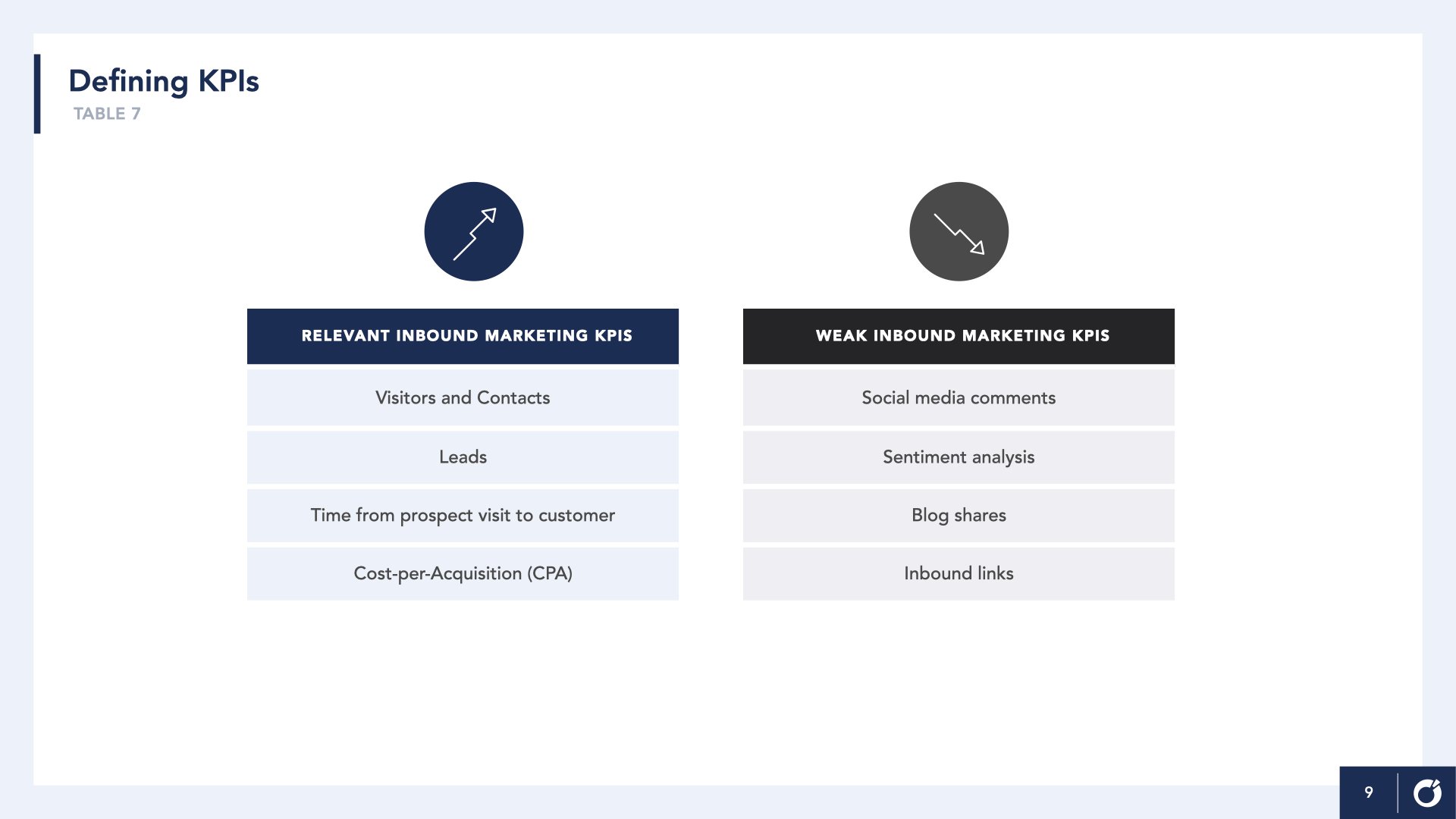
Strong, relevant KPIs connect to goals easily, indicate progress, and are interrelated. Metrics such as blog shares provide feedback on prospect response to marketing, but drawing a line from these to business revenue goals is tenuous at best.
Companies are more successful if they can quantify visitors, contacts, and leads, and use these data points comparatively:
- Divide total generated leads by total visitors to obtain the visitor-to-lead conversion rate.
(measures visitors who convert by exchanging contact info to accept an offer) - Divide total generated customers by total leads to obtain the lead-to-customer conversion rate.
(measures leads who convert by completing a purchase transaction. - Divide total generated customers by total visitors to obtain the conversion rate of all traffic to the site.
(measures all visitors who converted by completing a purchase transaction)
Finally, comparing cycle time from visit to lead, lead to customer, or visit to the customer, marketers can determine the average turn time for each phase or the overall marketing-sales cycle to measure against benchmarked goals and identify optimization points.
In order to increase overall aligned traffic, brands can optimize the various “hooks” used to drive initial visits, such as social media or brand landing pages. Increasing total aligned traffic to the brand site is a metric that ties to revenue goals.
However, marketers may not want to make the funnel wider at the top, but to make the lower funnel wider instead so that the percentage of visits that become customers is larger. If the volume of visitors (and customers) keep increasing with a non-moving ratio, it suggests no insights about the customer journey were applied during the initiative.
Other key metrics marketers should be tracking:
- Cost-per-Lead: Inbound methodology helps pre-segment traffic, limiting the cost for lead acquisition; nevertheless, monitoring costs comparatively across channels and even each dedicated landing page helps inform marketing decisions.
- Cost-per-Acquisition (CPA) or Customer Acquisition Cost (CAC): Total cost to create a new customer.
- Customer Lifetime Value (LTV, or CLV): Businesses with well-integrated CRMs can calculate the average LTV for different customer profiles, using the LTV comparatively with CPA to determine full ROMI.
Maximizing an Inbound Marketing Strategy
An effective inbound marketing strategy demands due diligence and application of contemporary practices that fall across a wide spectrum of technologies and tactics. Without proper analysis and long-term campaign-level planning and follow-through, a brand can easily waste time and money.
- Marketers must be able to match unique business needs to a complex interrelated mix of strategies and tactics effective for unique offerings and customers.
- In order to attract visitors to brand sites, marketers should be current on search engine algorithms and social media back-end functionality.
- To convince visitors to spend time there, marketers must be able to apply contemporary web design to support specific customer journeys.
- To create engaging user experiences across numerous buyer journey positions, and to raise visibility and extend pull reach, inbound marketing leverages tactics across a multitude of domains.
Multiple fields of expertise intersect in most successful digital marketing initiatives of any size, requiring competencies in strategic planning, competitive market assessment, value offering design and delivery, and multiple supporting platforms. Applying elements of the wide set of marketing-related domains ensures an inbound program lifecycle that reaches the full addressable market, provides unique value to customers, and creates a trusted, growing brand.
Suggested Reading
Cox, Lindsay K. 2020. Lead Generation: A Beginner’s Guide to Generating Business Leads the Inbound Way. Hubspot.
https://blog.hubspot.com/marketing/beginner-inbound-lead-generation-guide-ht
Detailed lead process descriptions and guidelines for different inbound lead generation strategies, data capture, tools, and industry benchmarks.
Hicks, Kristen. 2019. Why Paid Advertising is an Important Part of Inbound Marketing. Kunocreative.
https://www.kunocreative.com/blog/paid-ads-important-part-of-inbound-marketing
Quick overview of the main intersections of inbound and paid channels.
HubSpot. What is Inbound Marketing?
https://www.hubspot.com/inbound-marketing
Strong introductory article covering the main components and strategies of inbound marketing.
Aquilante, Laurie. 2021. The Reason Companies Miss Their Revenue Goals, In One Chart. Hubspot.
https://blog.hubspot.com/marketing/miss-revenue-goals-chart
Current and recent marketing statistics divided by key areas, e.g., eCommerce, voice search, content marketing, video, etc.
Rakacreative. How Inbound Marketing Can Help Your Business.
https://www.rakacreative.com/inbound-marketing/
Broad introduction that provides historical context, application of tactics to phases, results, and functional explanations. Includes a large glossary of relevant marketing and technology terms.
Reza, S., Ho, D., Ling, R., Shir, H., and Calvert, G. 2021. Don’t Count on Free Trials to Win You Customers. Harvard Business Review.
https://hbr.org/2021/01/dont-count-on-free-trials-to-win-you-customers
Recent research on a wide variety of trial offers used in marketing, discussion of types of trials (e.g., limited functionality, time-limited, experiential, etc.), and how targeting reveals that highest valued customers are often the least amenable to the offers. Of interest to any business considering similar marketing offerings.
Stahl, Stephanie. 2019. 2020 B2B Content Marketing: What the Successful Do. CMI.
https://contentmarketinginstitute.com/2019/10/success-differentiators-b2b-research/
A detailed current list of statistics for B2B content practices, provides insight into dominant trends and solution choices.
Weidert Group. 2018. What is Inbound Marketing for Industrials? Downloaded from
https://www.weidert.com/inbound-marketing-for-industrial-manufacturers-lp
Presents an application of inbound methodology for the industrial sector, with clear examples that tie specific strategies and tactics to real-world business.









